
Holy Trinity Church is in Church Road, Wavertree, Liverpool, Merseyside, England. It is an active Anglican parish church in the diocese of Liverpool, the archdeaconry of Liverpool, and the deanery of Toxteth and Wavertree. The church is recorded in the National Heritage List for England as a designated Grade II* listed building. It was described by John Betjeman as "Liverpool's best Georgian church".
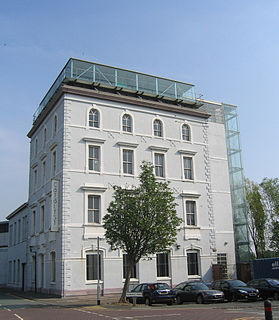
Widnes is an industrial town in the Borough of Halton, Cheshire, England, on the north bank of the River Mersey where it narrows at Runcorn Gap. The town contains 23 buildings that are recorded in the National Heritage List for England as designated listed buildings. Of these, 5 are classified at Grade II*, and 18 at Grade II; Widnes has no Grade I listed buildings. In the United Kingdom, the term "listed building" refers to a building or other structure officially designated as being of special architectural, historical, or cultural significance. Listed buildings are categorised in three grades: Grade I consists of buildings of outstanding architectural or historical interest; Grade II* includes particularly significant buildings of more than local interest; Grade II consists of buildings of special architectural or historical interest. Buildings in England are listed by the Secretary of State for Culture, Media and Sport on recommendations provided by English Heritage, which also determines the grading.

The Memorial to Heroes of the Marine Engine Room is a granite monument located on St. Nicholas Place, at the Pier Head, in Liverpool, England.

Rochdale Cenotaph is a First World War memorial on the Esplanade in Rochdale, Greater Manchester, in the north west of England. Designed by Sir Edwin Lutyens, it is one of seven memorials in England based on his Cenotaph in London and one of his more ambitious designs. The memorial was unveiled in 1922 and consists of a raised platform bearing Lutyens' characteristic Stone of Remembrance next to a 10-metre (33 ft) pylon topped by an effigy of a recumbent soldier. A set of painted stone flags surrounds the pylon.

St Mary's Church is in North Drive, Wavertree, Liverpool, Merseyside, England. It is an active Anglican parish church in the deanery of Toxteth and Wavertree, the archdeaconry of Liverpool, and the diocese of Liverpool. The church is recorded in the National Heritage List for England as a designated Grade II listed building.
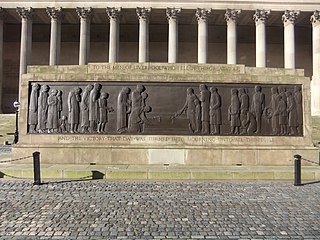
Liverpool Cenotaph stands on St George's Plateau, to the east of St George's Hall in Liverpool, England. It was erected as a memorial to those who had fallen in the First World War. The dates of the Second World War were subsequently added. The cenotaph consists of a rectangular block of stone on a stone platform, with bronze, low-relief sculptures on the sides depicting marching troops and mourners. It was designed by Lionel Budden, with carving by Herbert Tyson Smith. Initially designated as a Grade II listed building, its status was raised to Grade I in 2013.
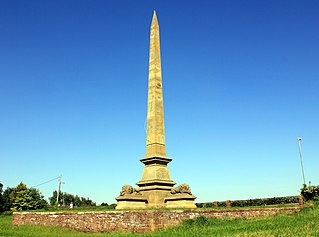
The Barnston Memorial is an obelisk in Churton Road, Farndon, Cheshire, England. It commemorates Roger Barnston, a military officer who died in 1857 from wounds sustained at the Siege of Lucknow. His memorial consists of an obelisk standing on a plinth, surrounded by four lions. It is recorded in the National Heritage List for England as a designated Grade II* listed building.

Macclesfield Cenotaph is a World War I memorial in Park Green, Macclesfield, Cheshire, England. It was unveiled in 1921, and consists of a stone pillar and pedestal and three bronze statues. One statue is that of a mourning female, and the others comprise Britannia laying a wreath over a soldier who had died from gassing, an unusual subject for a war memorial at the time. The memorial is recorded in the National Heritage List for England as a designated Grade II* listed building.

Moulton War Memorial stands in Main Road, Moulton, Cheshire, England. It consists of a marble statue of a soldier standing on a sandstone pedestal, and is surrounded by a wrought iron fence. The memorial was designed by Samuel Welsby, and unveiled in 1920. It is recorded in the National Heritage List for England as a designated Grade II listed building.

The Leverhulme Memorial stands to the west of the Lady Lever Art Gallery on the junction of Windy Bank and Queen Mary's Drive, Port Sunlight, Wirral, Merseyside, England. It commemorates the life of William Lever, 1st Viscount Leverhulme, the businessman who created the factory and model village of Port Sunlight. The memorial was designed by James Lomax-Simpson, and the sculptor was William Reid Dick. It consists of an obelisk with a figure on the top, with a separate group of four figures beside it. The memorial was unveiled in 1930. It is recorded in the National Heritage List for England as a designated Grade II listed building.

The Port Sunlight War Memorial stands in a central position in the model village of Port Sunlight, Wirral, Merseyside, England. The founder of the village and employer of its residents, William Lever, was anxious to have a memorial to commemorate those of his workers who had been lost in the First World War. As early as 1916 he commissioned Goscombe John to design a war memorial, which was completed and unveiled in 1921 by two of his employees. It consists of a granite runic cross with bronze statues and reliefs and has the theme "Defence of the Realm". On the memorial are the names of all of the company's employees who died as a result of both World Wars. It is recorded in the National Heritage List for England as a designated Grade I listed building.

The Bootle War Memorial is in Bootle South Recreation Ground, Bootle, Sefton, Merseyside, England. It was paid for partly by a grant from the local council, and partly by public subscription. The sculptor was Herman Cawthra, with assistance in the design from Hubert Ernest Bulmer, the borough's art director. The monument consists of a mother and child on top of an obelisk, which is surrounded by the figures of three servicemen. It was unveiled in 1922, and the names of those killed in the Second World War were added in 1948. The memorial was recorded in the National Heritage List for England as a designated Grade II listed building in 1986, and upgraded to Grade II* in 2018.

The Monumental Obelisk, Southport, stands on the Promenade in Southport. Merseyside, England. It commemorates a number of events, mainly relating to the work of the Southport lifeboats, and in particular the loss of fourteen lifeboatmen when their boat capsized in 1886. The monument was designed by Thomas Robinson, and is constructed in granite. It is recorded in the National Heritage List for England as a designated Grade II listed building.

Southport War Memorial is in London Square, Lord Street, Southport, Merseyside, England. It consists of an obelisk flanked by two colonnades in the form of Greek temples. Outside the colonnades are memorial gardens, each containing a Pool of Remembrance and fountains. The memorial was designed by the local architects Grayson and Barnish, and the carving was executed by Herbert Tyson Smith. It was unveiled in 1923 by the Earl of Derby. Following the Second World War and subsequent conflicts further inscriptions and names have been added. The memorial is recorded in the National Heritage List for England as a designated Grade II* listed building.

The Portsmouth Naval Memorial, sometimes known as Southsea Naval Memorial, is a war memorial in Portsmouth, Hampshire, England, on Southsea Common beside Clarence Esplanade, between Clarence Pier and Southsea Castle. The memorial commemorates approximately 25,000 British and Commonwealth sailors who were lost in the World Wars, around 10,000 sailors in the First World War and 15,000 in the Second World War. The memorial features a central obelisk, with names of the dead on bronze plaques arranged around the memorial according to the year of death.

Lewes War Memorial is a war memorial at the top of School Hill in the centre of Lewes in East Sussex, prominently sited at the junction of High Street and Market Street. It commemorates 251 men from Lewes who died in the First World War, and 126 who died in the Second World War. It was unveiled in 1922 and became a listed building in 1985.

Trumpington War Memorial is a war memorial cross in the village of Trumpington, on the southern outskirts of Cambridge. The memorial was designed by Eric Gill. It was unveiled in 1921, and became a Grade II* listed building in 1999.
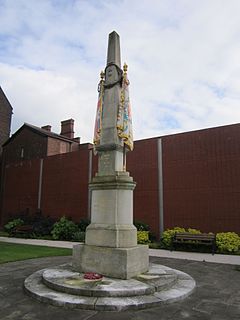
The Lancashire Fusiliers War Memorial is a First World War memorial dedicated to members of the Lancashire Fusiliers killed in that conflict. Outside the Fusilier Museum in Bury, Greater Manchester, in North West England, it was unveiled in 1922—on the seventh anniversary of the landing at Cape Helles, part of the Gallipoli Campaign in which the regiment suffered particularly heavy casualties. The memorial was designed by Sir Edwin Lutyens. Lutyens was commissioned in light of a family connection—his father and great uncle were officers in the Lancashire Fusiliers, a fact noted on a plaque nearby. He designed a tall, slender obelisk in Portland stone. The regiment's cap badge is carved near the top on the front and rear, surrounded by a laurel wreath. Further down are inscriptions containing the regiment's motto and a dedication. Two painted stone flags hang from the sides.
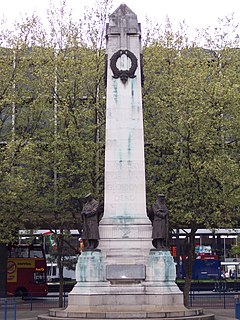
The London and North Western Railway War Memorial is a First World War memorial outside Euston railway station in central London, England. The memorial was designed by Reginald Wynn Owen, architect to the London and North Western Railway (LNWR) and commemorates employees of the LNWR who were killed in the First World War. The memorial is today a grade II* listed building.

Twickenham War Memorial, in Radnor Gardens, Twickenham, London, commemorates the men of the district of Twickenham who died in the First World War. After 1945, the memorial was updated to recognise casualties from the Second World War. The memorial was commissioned by Twickenham Urban District Council in 1921. It was designed by the sculptor Mortimer Brown, and is Brown's only significant public work. The memorial is unusual for its representation of a jubilant soldier returning home. It became a Grade II* listed structure in 2017.




















